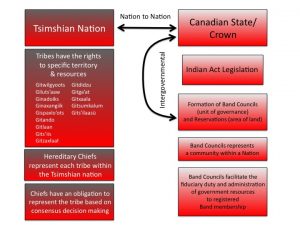To position my work, you may find my self-location here.
Here is a basic flowchart of what “Nation to Nation” consultation looks like between the Tsimshian Nation and the Canadian State.
There is a lot of “Nation to Nation” rhetoric from the federal and provincial governments in getting First Nations free, prior and informed contest. Here I’ve made a handy flowchart of the two legal traditions and systems of governance. This may explain how “Nation to Nation” negotiation has gone awry in the Tsimshian Territory.

On the left, the Tsimshian Nation occupies the Tsimshian Territory. The Tsimshian people are grouped into Tribes, where each Tribe has the right to specific territory and resources (ie. fishing, hunting, harvesting rights).
The Tribes are lead by Hereditary Chiefs, also called Simoyget in the Sm’algyax language, who are spokes people for the Tribe. The Hereditary Chiefs have an obligation to represent a Tribe based on consensus decision making. The Hereditary Chiefs must have a feast to recognize their status, whereby attending the feast and consuming the food, you are agreeing to the business taking place.
On the right, the Canadian state/ crown has imposed and monopolized their legal system over First Nations law. The state created the Indian act legislation to govern First Nations – deciding membership and displacing First Nations from their territory to live on reservations designated by the state.
The Indian Act laid out the band council and reservation system. Therefore the band council operates by the rules and regulations of the Indian Act and thus the Canadian state. This interaction between the state and the band council is intergovernmental, not Nation to Nation.
Band Councils represent a reservation within a territory, sometimes coinciding with a Tribe – but not always. Lax Kw’alaams represents the 9 allied Tribes, which are on the left side of the above list.
It is important to recognize that the people elected to the band council are also members of the community. These representatives are often experienced leaders who have built relationships and trust with the members of the community. Participation in the band system is a way to use the means that are available to advocate and provide for the community, while the remainder of our territory and wealth is occupied/ forcibly controlled but the State. This only complicates the path of garnering “Nation to Nation” consent.
This is a description of the two active forms of governance in the Tsimshian Territory. The Tsimshian Nation is not currently represented by a contemporary political organization, such as a tribal council.
———

To break down the Tsimshian governance structure even further, the Tribes are broken down into familial houses, and then a crest/clan system. It is common practice at First Nations events to reassert and recognize our position in society and our governance structure before proceeding with an event.
The Tsimshian governance structure is very complex and has been developed over thousands of years to ensure territorial rights are kept in line and kinship ties are accounted for. This is all recoded though our Adaawk, a formal collectively owned oral history (Marsden, 2002), and our Ayook, the traditional Tsimshian law.
Hereditary Chiefs have an obligation to lead in accordance with our Adaawk and Ayook.